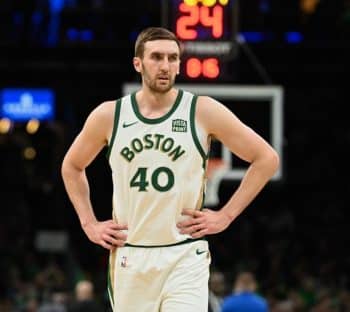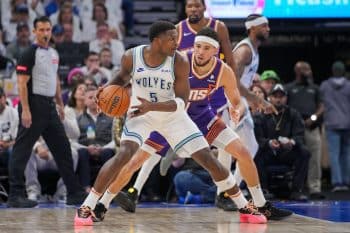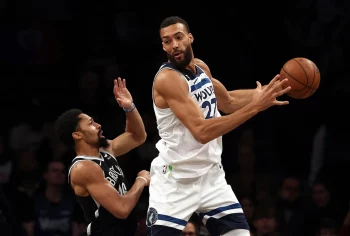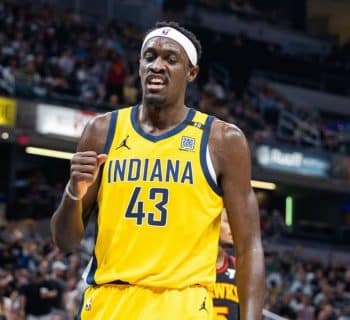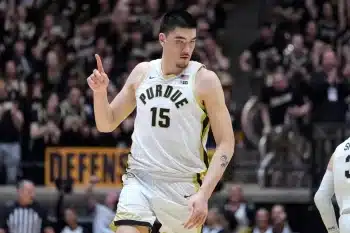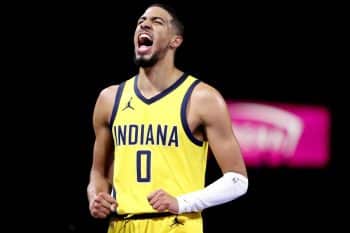NBA
Looking At The NBA Draft: The No. 7 Picks

There is hope on the horizon: as more and more teams continue to re-open their facilities, the NBA would seem that much closer to a return.
That said, there is still a very long road ahead. And, in the meantime, Basketball Insiders has done our best to help mitigate the monotony of quarantine. Recently, we’ve taken a look at the last decade of the NBA draft, breaking down each player pick by pick.
If you haven’t already, make sure to check out our analysis of the first, second, third, fourth, fifth and sixth overall picks. Today, we’ll be looking at the players taken with the seventh selection. So, without further ado, let’s get into it.
The Hits
Stephen Curry — Golden State Warriors — 2009
In the last 10 seasons, Curry, by far, is the best player to occupy the seventh draft slot. Arguably, he’s the best player to ever do so.
For a down-and-out franchise like the Warriors, Curry’s drop in 2009 was a franchise-altering stroke of luck. The Minnesota Timberwolves even doubled-dipped at the point guard position ahead of them, selecting Ricky Rubio and Jonny Flynn, yet the sharpshooter out of Davidson, the future two-time Most Valuable Player and three-time champion, fell into their lap.
Would Curry have led the Timberwolves to their first Larry O’Brien trophy? It’s hard to say. What isn’t hard to say is the major impact Curry has had on the NBA would transcend almost any alternate reality where Minnesota, or any other team for the matter, draft him ahead of Golden State.
If the first unanimous MVP in league history doesn’t convince you of that fact, his career stats might: 23.5 points, 4.5 rebounds, 6.6 assists, 1.7 steals and an NBA record (among players with at least 2000 attempts) 43.5 percent three-point percentage.
And if that doesn’t convince you, this might. Or this. Or this. Or…
You get it.
Harrison Barnes — Golden State Warriors — 2012
Barnes may not live up to his pick-mate, but he’s a solid pick in his own right.
As the Warriors third option to Curry and Klay Thompson, Barnes’ early numbers don’t impress. But the Warriors didn’t need him to do much, either — he may have been more a role player than bonafide “hit” for Golden State, but Barnes filled his role to the best of his ability and was a strong contributor on a championship roster.
And, with a move away from California, Barnes’ production took a major leap. In the four seasons post-Golden State, Barnes has averaged 17.4 points, on a 44.8 percent field goal percentage and a solid 37.4 percent from three, to go along with five rebounds per game.
Barnes averaged 14.2 shots per game, compared to the meager 8.5 he managed in his four seasons with the Warriors, and, while he may not carry an offense alone, he’d be a strong option on almost any squad.
If that’s not a hit, then I don’t know what is.
Jamal Murray — Denver Nuggets — 2016
The 2016 NBA Draft was often described as a “two-player” draft. Ben Simmons and Brandon Ingram were the superstars — beyond that, who cared?
Murray, as Jaylen Brown (No. 3) and Buddy Hield (No. 6) have, has seemingly proven everyone wrong just four seasons into his career.
After a promising rookie season, Murray took his game to a new level and hasn’t looked back. His scoring has improved year after year, while his percentages are strong and his penchant for success in the clutch would seem to be undeniable.
Alongside Nikola Jokic, Murray has pushed Denver into the Western Conference’s elite: Before the shutdown, Murray’s fourth season, the electric guard had averaged 18.8 points, 3.9 rebounds, 4.8 assists per game with the Nuggets once again in position to claim one of the Western Conference’s top seeds.
As Denver’s success persists, Murray’s star should only shine brighter. He’s already flashed, but don’t be shocked if Murray, even in a packed Western Conference, plays his name into the All-Star conversation in the near future.
The Misses
Ben McLemore — Sacramento Kings — 2013
It’s safe to say that any top-10 pick that’s had the career McLemore has should be categorized as a miss. He may not be a bust yet — he’s certainly redeemable, to a point, anyway — but McLemore just hasn’t lived up to his billing at this point in his career.
In seven seasons, McLemore has averaged nine points, 2.4 rebounds and 1.1 assists per game. A career 42.1 percent shooter, he’s struggled with his shot and, more importantly, his confidence.
After four seasons in Sacramento, McLemore managed just one season with the Memphis Grizzlies, a year in which he bounced between the NBA and G League, before he was traded back to Sacramento and, later, waived.
Here’s something a bit more positive, however: Before the season had cut short, McLemore had seemingly found his footing with the Houston Rockets.
With Gerald Green and Eric Gordon injured, McLemore earned some playtime. And, alongside James Harden and Russell Westbrook, the game seemed to have been simplified for him: in 63 games, McLemore played some of his best basketball as he averaged 9.8 points, shot 39.5 percent on 6.2 three-point attempts per game and played some strong defense.
As the seventh selection, it’s not the star he was made out to be. But it’s promising nonetheless. And, while McLemore isn’t there yet, it wouldn’t be a shock to see him play his way into the role player category in the near future.
Emmanuel Mudiay — Denver Nuggets — 2015
Mudiay, rather than joining the NCAA ranks, chose to play in China after graduating high school. His success there — 17.7 points, six rebounds, 5.8 assists, 1.6 steals — saw his hype explode in the lead up to the 2015 NBA Draft.
But, in hindsight, it really shouldn’t have.
There was a lot to like about Mudiay as a prospect. At 6-foot-3, 200 pounds, he certainly has the size and the athletic profile necessary to succeed in the NBA. But, unfortunately for the Nuggets, that’s about as good as it got.
From the jump, Mudiay struggled. And, while there were some games he would flash, those were few and far between. While his 12.8 points and 5.5 assists per game looked strong, the 36.4 field goal percentage and suspect defense that accompanied them did not.
Handed the starting job as a rookie, Mudiay would cede the role to Jameer Nelson in his second season. Later, on Denver’s guard-rich roster, he eventually lost the backup job, too. In his third year, the Nuggets traded Mudiay to the New York Knicks, where he was once again given the starter role and averaged 11.8 points, 2.9 rebounds and 3.9 assists in 82 games spread across two seasons. Now, in a reserve role with the Utah Jazz, he’s managed 7.3 points, 2.4 rebounds and 2.2 assists.
His game has certainly improved since his time in Denver. Most notably, his field goal percentage had jumped to 47.1 percent before the league’s shutdown, albeit on only six shots per game. Still, Mudiay hasn’t lived up to his draft slot and, at this point, it’s hard to imagine he ever will.
The Middle of the Road
Julius Randle — Los Angeles Lakers — 2014
Early on, Randle looked destined to serve as a role player. But, in recent seasons, he’s shown to be capable of far more.
Of course, as with most lottery prospects, there was the occasional flash. But, with the Lakers, Randle didn’t “wow” anybody on a consistent basis. The 13.5 points and 8.9 rebounds he averaged in his first four seasons didn’t exactly scream superstar, either.
Then, Randle made his way to the New Orleans Pelicans, and everything just seemed to click.
It’s just a two-season sample, but Randle has played near (if not at) an All-Star level in his post-Lakers career. In his lone season with the Pelicans, Randle blew up as he averaged 21.4 points, 8.7 rebounds, 3.1 assists and shot 52.4 percent from the field. He was one of only seven that season to average at least 21 points and 8 rebounds while playing in at least 60 games.
The other six? Giannis Antetokounmpo, Paul George, Karl Anthony-Towns, LaMarcus Aldridge, Joel Embiid and Russell Westbrook.
Randle’s surge had continued into the 2019-20 regular season with the New York Knicks. Before the NBA’s hiatus, the forward managed an impressive 19.5 points, 8.7 rebounds and 3.1 assists, and did so in arguably the most dysfunctional environment in the NBA, an achievement in and of itself.
After only two seasons of high-level play, it’s hard to justify Randle as a surefire “hit.” That said, he’s close, and that could change very quickly if he can continue to build on the progress he’s made in the last two seasons.
Lauri Markkanen — Chicago Bulls — 2017
Markkanen’s career trajectory would appear to be at a crossroads. And it’s not looking good.
The forward out of Arizona shined as a rookie, serving as Chicago fans’ light in the post-Jimmy Butler darkness. He averaged 15.2 points and 7.5 rebounds across 68 games. As a sophomore, Markkanen raised the bar despite the fact that he was limited due to injury — he averaged 18.7 and nine per game, respectively, in 52 contests.
No doubt, he had the look of a rising star.
But, in his third season, Markkanen has faced some significant regression. His output has either stagnated or worsened across the board — including career low scoring (14.7), rebounding (6.5) field goal (42.5) and three-point percentage (34.4) averages — and, having played 50 games, it’s unlikely he’ll see a marked improvement should the season resume.
Going forward, a change of scenery may do him some good. If not, or if he can’t get right some other way, Markkanen might slide further and further away from that “hit” moniker and toward that of a role player (or worse), an idea that would have been laughed at after such a promising start to his career.
Wendell Carter Jr. — Chicago Bulls — 2018
For Carter Jr., it’s just too early to call.
He’s certainly shown promise. In 84 games across his first two seasons, Carter has looked the part as he’s averaged 10.8 points, 8.2 rebounds, 1.1 blocks, shot 50.8 percent from the floor while consistently playing hard on the defensive end.
But it’s that number: 84. With so few games played, it’s hard to say one way or the other what Carter’s future could look like. Could this be his best? Unlikely. But is it a possibility? Certainly. We just don’t know.
As he gets more games under his belt, that future should come further into focus. He certainly has the tools to put it together, it’s just a matter of whether or not Carter can effectively make use of them.
Coby White — Chicago Bulls — 2019
Yes, another Bull.
Like Carter, there just isn’t enough to go on to make a solid declaration on White. Yes, the talent would seem to be there — White averaged 13.2 points, 3.5 rebounds, 2.7 assists in 65 games — but the North Carolina product struggled in a number of categories, namely field goal percentage (39.4 percent).
He certainly has the potential to blossom. But the NBA has seen far too many promising rookie seasons followed up by sub-par careers. For White, at this point, it’s just a wait-and-see.
The Role Players
Greg Monroe — Detroit Pistons — 2010
Over the course of his career, Monroe was atrocious on defense. But, and despite the fact that he’s not currently under contract, his offensive game has saved him from “miss” status.
Monroe made an instant impact as a rookie, as he posted 9.4 points and 7.5 rebounds per game. Over the next four seasons, Monroe averaged a strong 15.6 points, 9.7 rebounds and 1.2 steals per game on 49.9 percent shooting. It was more of the same in the first of a three-year, $50 million deal he signed with the Milwaukee Bucks: 15.3 points and 8.8 rebounds on 52.2 percent from the field.
But, after that? It’s not pretty.
It’d be hard for any team to keep a center that doesn’t block many shots on the floor for extended stretches. Monroe, being such a center (with a career average of .6 blocks per game), saw a dip in minutes, from 29.3 to 22.5 per game. His scoring and rebounding averages, 11.7 and 6.6, respectively, suffered.
In the final year of his deal, Milwaukee traded Monroe to the Phoenix Suns, who later released him.
Despite that ugly turn, Monroe proved a desired commodity as a potential offensive sparkplug off the bench. He finished the 2018-19 season with the Boston Celtics before splitting last season between the Toronto Raptors, Celtics and Philadelphia 76ers.
Bismack Biyombo — Charlotte Bobcats — 2011
Were it not for his defensive acumen, Biyombo would have certainly gone down as a miss.
The 6-foot-8 center, over the course of his career, has brought almost nothing on offense. For his career, the center has managed a, to say the least, underwhelming 5.1 points and 6.2 rebounds per game. The 52.1 percent two-point field goal percentage he’s sported over nine seasons is 67th in the NBA in that span — not great when the majority of your shots come within three feet of the basket.
And yet, in one season with the Toronto Raptors, Biyombo parlayed his biggest strength, his defense, into a four-year, $72 million deal with the Orlando Magic in 2016.
The merit of that deal could certainly be argued, but that’s neither here nor there. In reality, Biyombo earned that deal as a defensive specialist and, despite inconsistent minutes, has continued to play much of the same role since.
The draft, ultimately, is a crapshoot. You can only analyze so much tape, run so many workouts before giving way to blind luck. That said, over the last 10 seasons, the NBA, collectively, has made great use of the seventh selection. Who could be the pick’s next success story?
Again, if you haven’t already, make sure to check out our analysis of the first six picks. And stay tuned for the rest of our draft lookback series.
